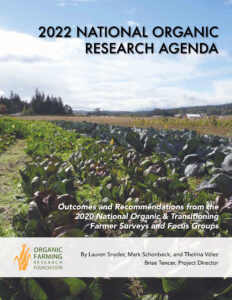 The Organic Farming Research Foundation 2022 National Organic Research Agenda (NORA) is a report informed by surveys and focus groups conducted in 2020 with over 1,100 certified organic farmers and ranchers across North America.
The Organic Farming Research Foundation 2022 National Organic Research Agenda (NORA) is a report informed by surveys and focus groups conducted in 2020 with over 1,100 certified organic farmers and ranchers across North America.
What Farmers Said
- In the NORA report, 74% of survey respondents cited insect/pest management as a substantial technical assistance need.
- Specific feedback from organic farmers also underscores the need for additional research on managing pests such as flea beetle.
Download OFRF’s Pest Profiles
Know Your Pest
Flea beetles are highly mobile and may fly long distances in search of suitable plants.
Eggs are elliptical in shape and white to yellowish gray in color. They are laid at the base of host plants, or in soil around the base of the plant. Eggs hatch in 11-13 days (at 77°F). Adults mate and lay eggs singly or in groups of 3-4 in soil at the base of host plants.
Larvae feed on the root hairs and taproots of seedlings. Damage is usually minimal at this phase except in the case of the Tuber Flea Beetle which feeds on potato tubers and the roots of potatoes. When larval development is complete, larvae pupate in small earthen cells for 9-13 days before emerging as adults.
Managing Flea Beetle
Stress these pests by:
- Planting a trap crop to attract pests away.
- Remove alternative food sources.
- Interrupt life cycles.
- Create a barrier with floating row cover.
Enhance the population of beneficial bugs such as Braconid wasp (Microctonus vittatae), Lacewing larvae (Chrysoperla spp.), Big eyed bugs (Geocoris spp.), and Damsel bugs (Nabis spp.). Beneficial plantings of anise, dill, chamomile, marigold, or clover can enhance floral resources and encourage predatory insects.
Integrating healthy crop diversity, building soil health, and instituting crop rotations can also support pest management.


